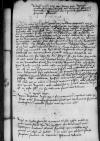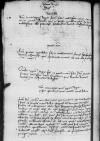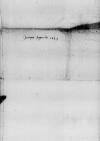Cum ad animi mei iudicium revocem, cum aequa lance perpendam, ipsum in intimis animi praecordiis trutinem, quantus fuerit tuus favor, tua clementia, Praesul dignissime, non possum non, quin aequi bonique consulam quicquid Tua Dominatio meae commiserit fidei, quamquam sciam meum sermonem barbarie{i} feci conspurcatum. Sed etsi cognoscam me idoneum non esse ad scribenda ea, quae Tua Celsitudo mihi commiserit, tamen pro viribus adnitar, ut ea efficiam, quae Tuae Dominationi erunt voluptati solacioque. Nam quicquid ego habeo, hoc Tuae Dominationi acceptum ferre possem. Quam ob rem Deum omnium rerum architectam oro, obsecro atque obtestor, ut Tuae Dominationi Nestoreos reddat annos, et ut has meas parvulas s<ch>edulas aequi bonique consulere non dedigneris, quamquam neque ⌊Ciceronis⌋ neque ⌊Demostenis⌋ eloquentiam oleant, sed etsi barbaries me corripiat, tamen pro virili molimine adnitar, ut Tuae Celsitudini non sim taedio.
Hic enim scopus est, hic labor, haec meta, ad quam meas (ut aiunt) sagittas divino favore derigam, nempe ut Tuae Dominationi plenis (ut aiunt) tibiis decantem facta atque gesta ⌊regis Angliae⌋, quae a superinscribed⌈aa superinscribed⌉ me numero colligi non possunt, quoniam tanta sunt, sed quae ad animi mei iudicium revocari possunt, numero explicabuntur, quoad mea diligentia sese extenderit. Ego, Georgius Rogenellus Polonus, Tuae Celsitudinis parvus servulus, in ⌊Anglia⌋ octo annis sub reverendissimo, illustrissimo paper damaged⌈[mo]mo paper damaged⌉ piissimoque domino ⌊Cranmero archiepiscopo Cantuariensi⌋ vitam peregi. In quibus octo annis, quae in intimis animi praecordiis trutinari possu<n>t, numero colligentur, quot uxores duxerit, quot nobiles sub eo mortem obierunt et quae ab eo gesta sunt, hic sine ulla mora paucis verbis declarabo.
V uxores duxit.
1 annus on the margin⌈1 annus1 annus on the margin⌉
Uxorem ⌊Katharinam⌋ duxit atque in suum matrimonium copulavit nobili ex stirpe natam serenissimi ⌊imperatoris⌋ sororem(!)[1], quam repudiavit ob sanguinis coniunctionem orig. coniungsionem⌈coniunctionemconiunctionem orig. coniungsionem⌉, quoniam fratris erat uxor (ut aiunt).
2 anno
2 anno on the margin⌈2 anno2 anno on the margin⌉ ⌊Annam⌋ ex ⌊Anglia⌋ progenitam in matrimonium eam sibi iunxit orig. iungsit⌈iunxitiunxit orig. iungsit⌉ nobili ex gente natam, filiam domini ⌊de Wylsher⌋, quae maecenatem meum ⌊archiepiscopum Cantuariensem⌋ plurimi faciebat. ⌊Quae⌋ o mortem obiit, quoniam cum aliis rem habuit (ut aiunt), quae plurimum sacri written over e⌈eii written over e⌉s scripturis favebat et litteratos quam plurimum diligebat.
 BCz, 1597, p. 898
BCz, 1597, p. 898
Iohannes Dei gratia
Ih(es)us
Tertio anno
3 anno. on the margin⌈3 anno.3 anno. on the margin⌉ Anno tertio uxorem duxit ⌊Ianam⌋ filiam nobilissimi ⌊militis⌋ totius ⌊Angliae⌋, co cui nomen est superinscribed⌈estest superinscribed⌉ Morley(!), quae in partu o(?) mortem obiit. Ex ⌊qua⌋ nobilissimus ille princeps ⌊Edwardus⌋ divina indulgentia processit.
4 on the margin⌈44 on the margin⌉
Quarto anno
Anno quarto copulavit sibi in matrimonium ⌊sororem⌋ illustrissimi ⌊ducis Clevensis⌋, quam repudiavit, quoniam ea erat alii promissa (ut aiunt).
Quintam uxorem duxit fil ex ⌊Anglia⌋ natam ⌊filiam⌋ s domini ⌊Hawardi⌋, fratris nobilissimi ⌊ducis Norfolciae⌋, quam ducere decrevit antequam haec in Angliam rediisset.
Nunc narravimus, quas uxores duxit, postea ostendemus, quos nobiles morti dederit.
Primum dominum ⌊Morum⌋ meae aetatis virum eximio ingenio, ex<c>ellenti doctrina, duas ob causas morti dedit, primum ob ⌊Romanum pontificem⌋, secundo ob matrimonium illud dominae ⌊Katharinae⌋ sororis(!) ⌊imperatoris⌋. Eandem ob causam obiit ille ⌊episcopus Roffensis⌋, vir ingenio eximio, eandem ob causam obierunt etiam quam plurimi nobiles, quos numero colligere non possum. Cum primum enim ⌊Romanum pontificem⌋ ⌊rex Angliae⌋ abigebat, tum ⌊Polus⌋ regia ex stirpe natus ⌊Romam⌋ adiit, qui a Romano hidden by binding⌈[o]o hidden by binding⌉ pontifice cardinalis effectus est. Ob cuius causam quam plurimi nobiles mortem obierunt regio ex sanguine nati, primo dominus Marques, dominus ⌊Montigue⌋, quam plurimi episcopi, nobiles etiam feminae ms. feomine(!)
⌈feminaefeminae ms. feomine(!)
⌉, dominus etiam ⌊Cromell⌋ mortem obiit, dominus ⌊Hungerford⌋ et quam plurimi alii nobiles plus quam viginti.



 BCz, 1597, p. 897
BCz, 1597, p. 897